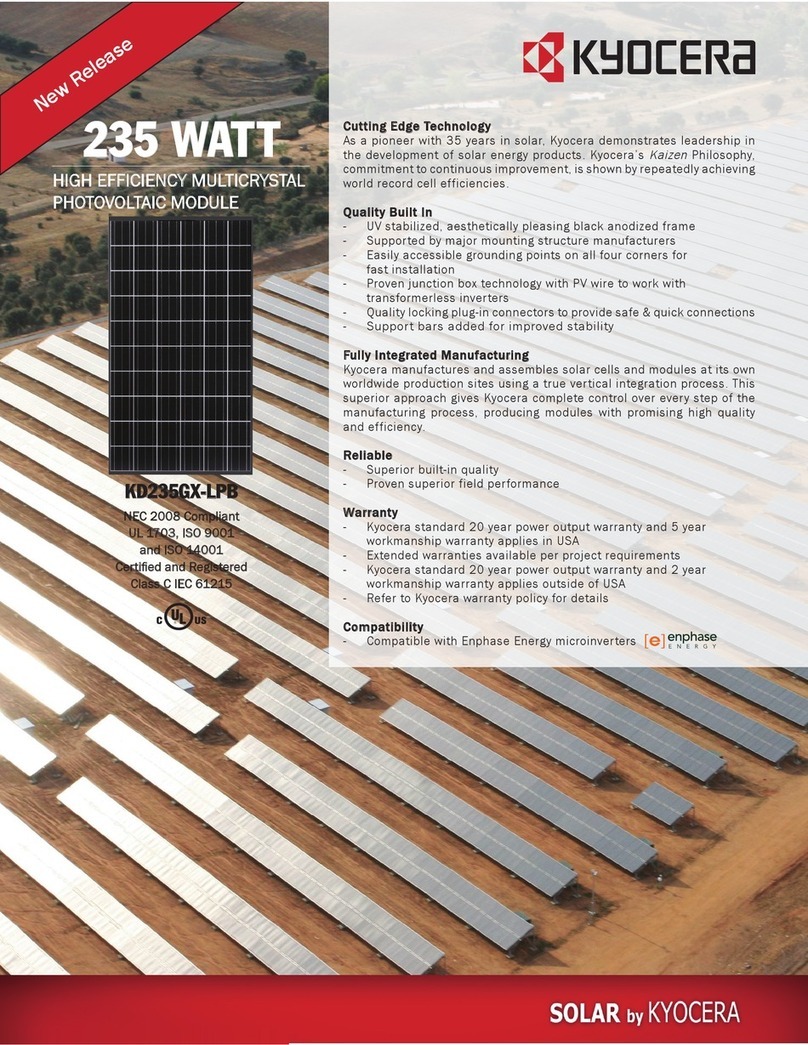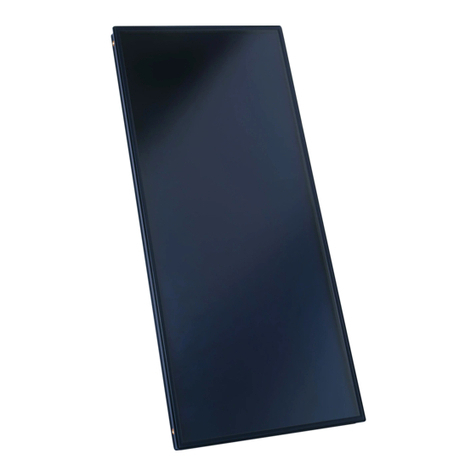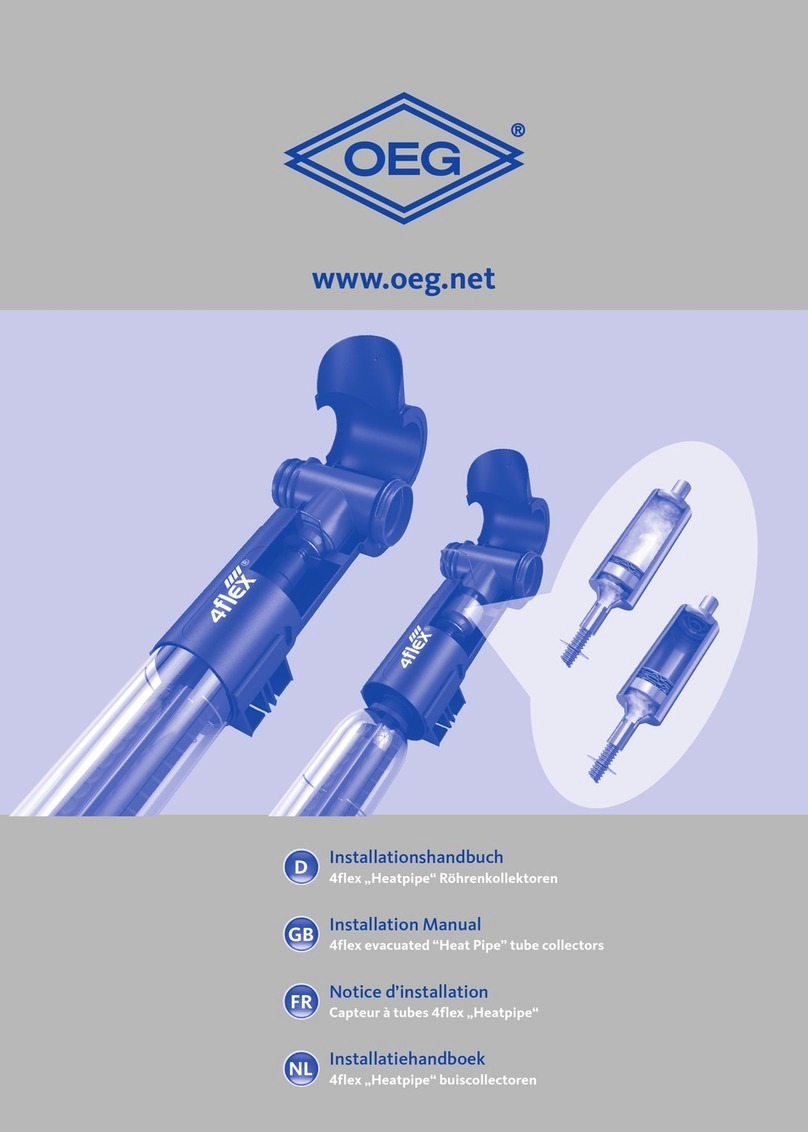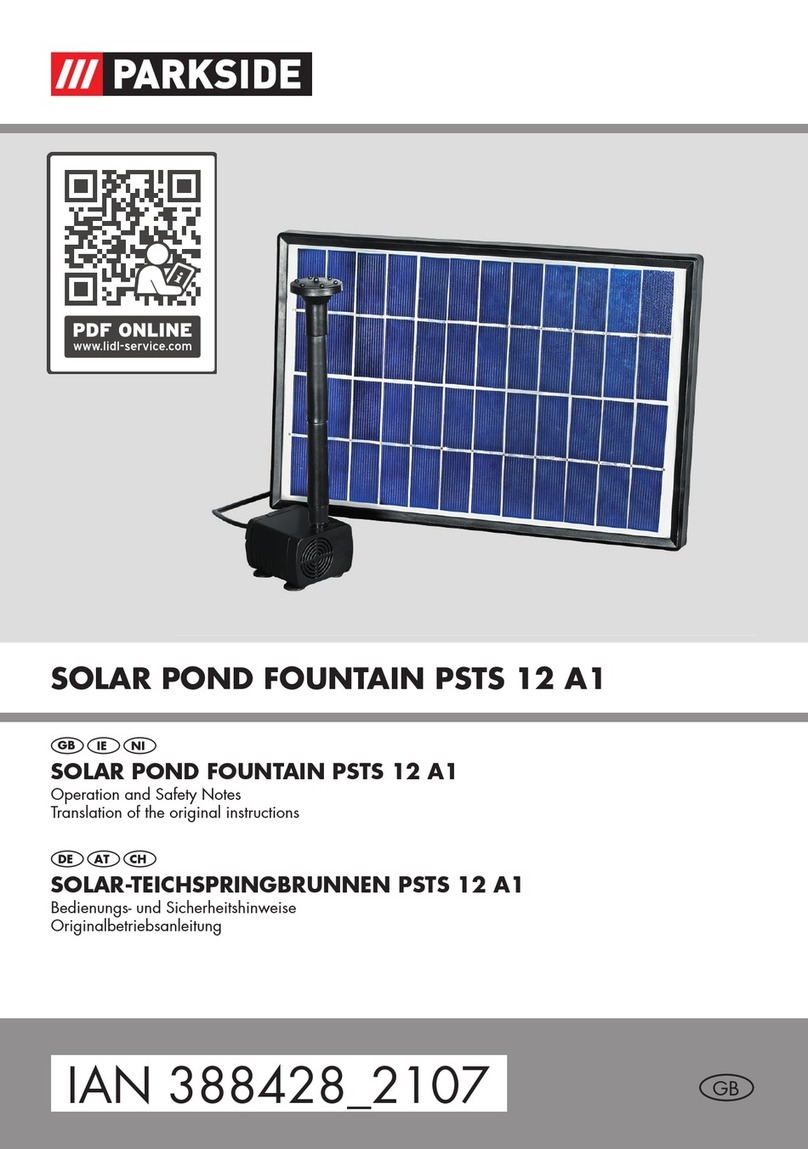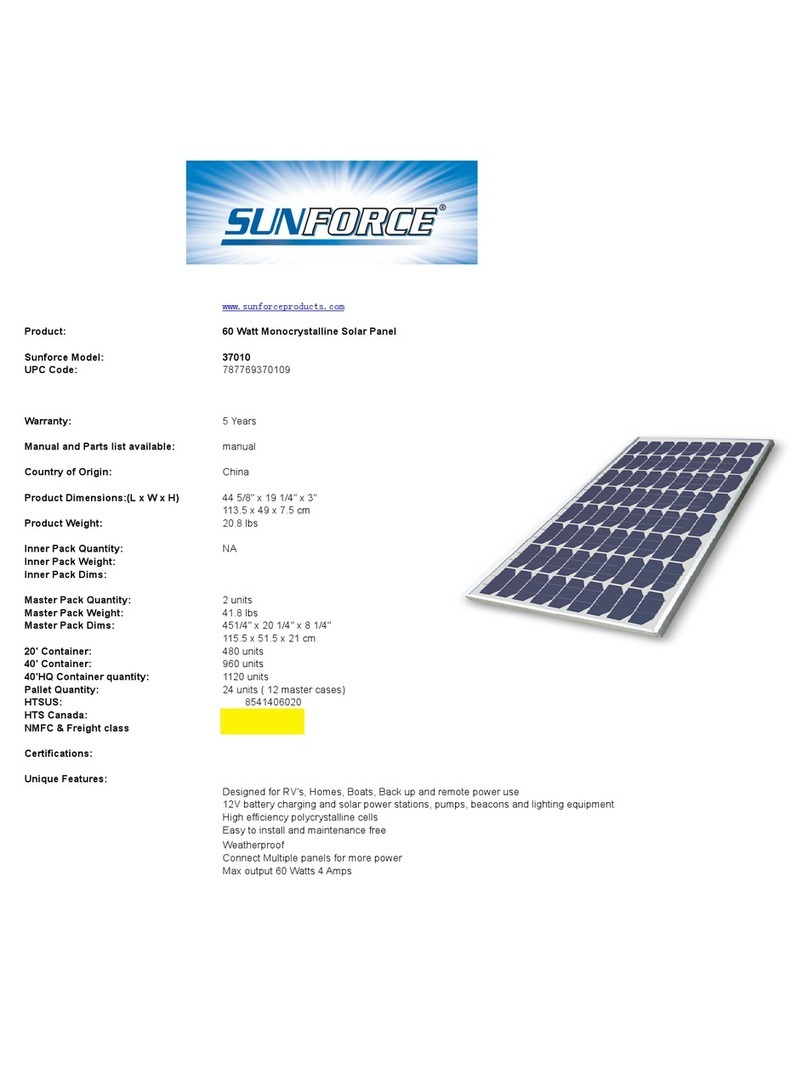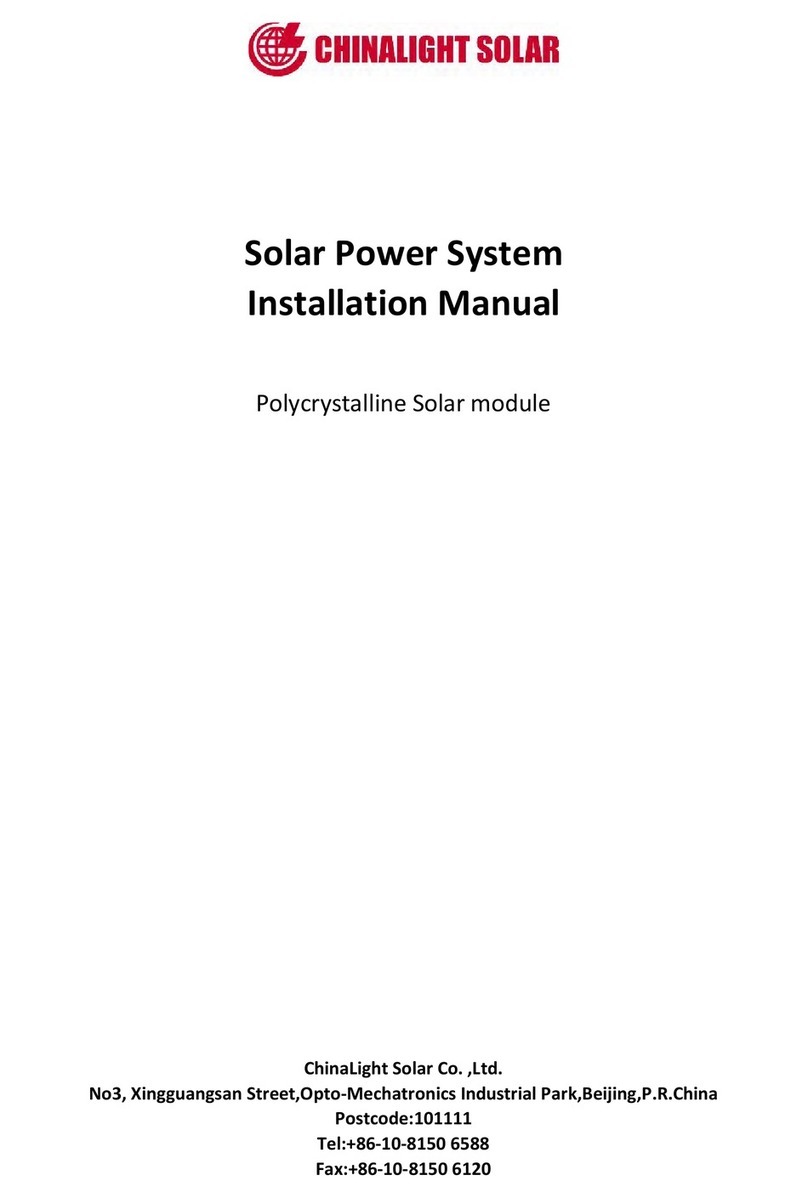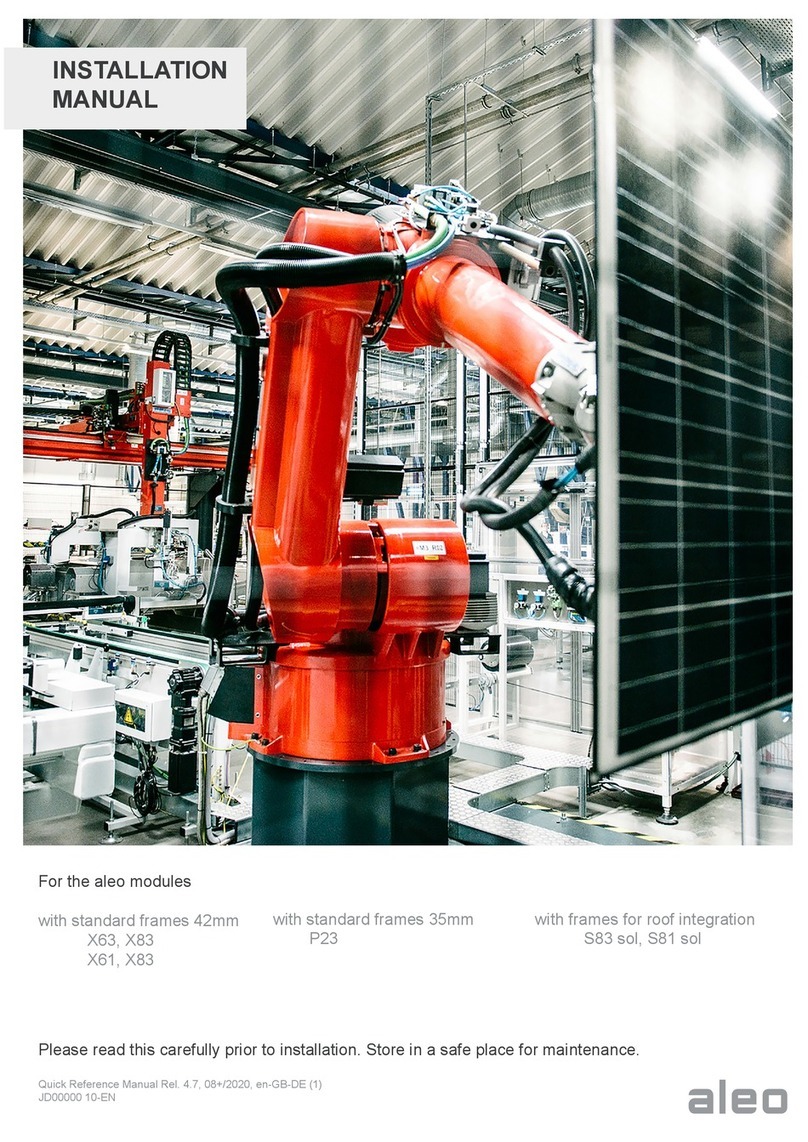HelioSphera HS Series Setup guide

10-SSI-001_rev.005_ENG Page 1of 51
SAFETY AND INSTALLATION
INSTRUCTIONS

10-SSI-001_rev.005_ENG Page 2of 51
Content Table
1. INTRODUCTION................................................................................................................. 4
2. PURPOSE OF THIS DOCUMENT...................................................................................... 5
3. GENERAL INFORMATION................................................................................................. 6
4. SAFETY INSTRUCTIONS .................................................................................................. 7
4.1 General Safety............................................................................................................. 7
4.2 Electrical Safety........................................................................................................... 8
4.3 Fire Safety................................................................................................................... 9
4.4 Hazardous Locations................................................................................................... 9
5. MECHANICAL INSTALLATION .........................................................................................10
5.1 HS Series ...................................................................................................................10
5.1.1 HS Atlas Series.......................................................................................................11
5.1.2 HS Venus Series.....................................................................................................15
5.1.3 HS Glass-Glass Series............................................................................................18
5.2 Location and Tilt Angle ...............................................................................................23
6. ELECTRICAL INSTALLATION...........................................................................................24
6.1 Grounding...................................................................................................................30
6.2 Suitable Inverters........................................................................................................30
6.3 Bypass diode..............................................................................................................31
7. MAINTENANCE.................................................................................................................32
7.1 Cleaning .....................................................................................................................32
8. IN CASE OF BREAKAGE/RECYCLING SYSTEM.............................................................33
9. PACKAGING AND TRANSPORTATION SPECIFICATIONS .............................................34
9.1 Storing........................................................................................................................34
9.2 Transportation box specifications................................................................................35
10. PHYSICAL SPECIFICATIONS...........................................................................................37
10.1 Module........................................................................................................................37
10.2 Junction Box...............................................................................................................39
10.2.1 Diode.......................................................................................................................40
10.2.2 Cables.....................................................................................................................40
10.2.3 Connectors..............................................................................................................41
11. ELECTRICAL CHARACTERISTICS...................................................................................42
12. CERTIFICATES.................................................................................................................43
12.1 Modules......................................................................................................................43
12.2 Junction boxes............................................................................................................47
12.3 Cables ........................................................................................................................48

10-SSI-001_rev.005_ENG Page 3of 51
12.4 Connectors.................................................................................................................49
12.5 Factory Inspection.......................................................................................................50
12.6 Quality Management System......................................................................................51
Edition: October 2011

10-SSI-001_rev.005_ENG Page 4of 51
1. INTRODUCTION
HelioSphera S.A. (HS) thin-film PV modules (Micromorph™ technology) are distinguished
in the marketplace by their efficacy in numerous applications, superior longevity and maximum
efficiency.
Micromorph™solar cell has a dual structure with an amorphous and microcrystalline
silicon layer. The amorphous layer is sensitive to the visible range of the solar radiation, while
the microcrystalline layer converts the infrared part of the spectrum into electricity which results
to an excellent performance in comparison with other solar cell technologies.
HS modules have unique design properties - such as a higher energy yield in low-light
conditions, a lower vulnerability to deviations of azimuth and tilt angles, and an improved
temperature coefficient which make them suitable for use both in optimal and in traditionally
non-optimal conditions.
These advantages also improve performance on partially shaded surfaces, resulting in
higher output using the lower cost production methods of thin-film modules. In crystalline solar
cells the light energy is absorbed within a thin surface layer (~10 μm) while using a total
thickness of approximately 180 μm of material. The Micromorph™ technology needs only 3 μm
to absorb a similar amount of light energy with no other silicon required. The costly cutting of the
relatively thick crystalline silicon blocks is eliminated, as micromorph silicon is deposited directly
onto the glass surface.

10-SSI-001_rev.005_ENG Page 5of 51
2. PURPOSE OF THIS DOCUMENT
The purpose of this document is to provide clear instructions on how to install HelioSphera
photovoltaic modules, in order to use them as easy and safely as possible.
HS products not installed according to guidelines will void the warranty. HelioSphera
assumes no liability for damages incurred due to non-compliance with these instructions.
Please, also read the instructions for the other components which make up the total PV system.
Due to continuous innovation, research and product development, the guidelines in this
document are subject to change without notice. No rights can be derived from the document
and HelioSphera assumes no liability whatsoever connected to or resulting from the use of any
information contained herein.

10-SSI-001_rev.005_ENG Page 6of 51
3. GENERAL INFORMATION
This Photovoltaic Module produces electricity when exposed to the sun or other light
source. Array of many modules can cause lethal shock and burn hazards. Only authorized and
trained personnel should have access to these modules. The installer assumes the risk of all
lesions that can happen during the installation, included, the risk of electric shock.
Please read the entire safety and installation instruction manual carefully prior to product
installation. Also, carefully read the module data sheet provided with this product. This guide
pertains to modules installed within the European Union only. If a module is being installed
outside of Europe, contact HelioSphera or the product distributor.
Determine local permits, installation and inspection requirements before installing
module(s).
Do not attempt to disassemble the module, and do not remove any attached nameplates
or components! Doing so will void the warranty. Do not disconnect under load! An
electrical arc could occur and pass through the fingers and body of the person holding
the two ends of the connector.
Do not use mirrors or other hardware to artificially concentrate sunlight on the module.
Under normal conditions, a solar photovoltaic module is likely to experience conditions
that produce more current and/or voltage than reported at standard test conditions.

10-SSI-001_rev.005_ENG Page 7of 51
4. SAFETY INSTRUCTIONS
4.1 General Safety
Solar modules should only be used for the purposes for which they are intended (see
module installation for further details). All works on the PV system, i.e. installation,
commissioning, servicing and repairs, should be carried out by qualified and authorized
personnel only. During installation, all local and national electrical and building regulations,
health and safety regulations and accident prevention regulations should be strictly followed.
All protective measures regarding working at heights and preventing falls specified in
national and local health and safety codes and regulations should be implemented before and
during all work on roof-mounted and other PV array structures, and all necessary scaffolding
and other protective measures applied at the site of the installation. Protective helmets, gloves
and footwear should be worn during installation work. Protective goggles should be worn when
carrying out drilling, cutting or grinding work. Safety harnesses may be required in some
situations.
Unpacking the modules and storage: Utmost care is required when handling solar electric
modules. Be careful when unpacking, transporting, and storing the modules, they are subject to
breakage if they are not properly handled and installed:
Always transport and store the modules in the shipping container provided. Transport
modules in an upright position. It is recommended not to take them out of the packaging
until the moment of the installation. During installation, never let the modules in direct
contact on ground, concrete or tiles without intersecting a soft material. Scratches or
glass breakages may occur.
Carry modules always between two workers and with both hands (Do not use the
junction box as a handle).
Do not carry more than one module at a time.
Ensure modules do not bow under their own weight and do not place modules on top of
each other.
Do not drop modules or allow objects to fall on modules.
Do not carry the module by the cables.
Avoid setting the module down hard on any surface. Pay particular attention to the glass
edges.
Don’t mark using sharp tools and keep all electrical contacts clean and dry. Do not
handle modules when they are wet unless wearing the appropriate protective equipment.
Do not install this module integral with a roof or wall without a certified integration
mounting system.
Do not wear metallic jewelry while performing mechanical or electrical installation.

10-SSI-001_rev.005_ENG Page 8of 51
Avoid application of excessive bending or twisting forces to the modules.
Mandatory use of
gloves or other hand
protection
Mandatory use of
protective footwear
Safety helmet must
be worn
Mandatory use of
safety goggles
4.2 Electrical Safety
Be familiar with the basic principles of electricity and electrical equipment. Use properly
insulated tools and appropriate protective equipment such as safety shoes and insulated gloves
as well as protection goggles. Do not remove any parts originally installed or disassemble the
module.
Short circuits on the DC side of the installation can cause arcing. This is a burn and fire
hazard. Unlike arcs occurring in conventional low voltage AC wiring, these arcs are not self
extinguishing. The high temperatures generated by these arcs can destroy contacts and
connectors. If not handled and installed according to instructions, solar modules can present a
lethal hazard.
Cover module face(s) completely with opaque material to halt the production of electricity
when working with module wiring.
Disconnect module(s) from other sources of electricity, such as batteries or inverters,
when any work on the installation is being done.
Avoid contact with terminals when modules are exposed to light.
Exercise utmost caution when working on wiring, including the inverter installation.
Do not attempt to install or use a module with broken front cover glass or a damaged
back glass. They represent a shock hazard due to leakage currents, especially when
wet.
Do not connect HS modules directly to motor loads. Variation in PV module output power
as a function of solar irradiance may damage directly connected loads.
Make sure that all electrical connections are completely dry before they are assembled.
Materials, tools and working conditions need to be clean and dry.

10-SSI-001_rev.005_ENG Page 9of 51
The modules are qualified for application class A: Hazardous voltage (IEC 61730: higher
than 50V DC: EN 61730: higher than 120V), hazardous power applications (higher than 240W)
where general contact access is anticipated (Modules qualified for safety through EN IEC
61730-1 and -2 within this application class are considered to meet the requirements for safety
class II).
Danger electric shock risk
4.3 Fire Safety
HS modules have a Class E Fire Rating and must be installed over a roof of appropriate
fire resistance. Consult your local building department to determine approved roofing materials.
Do not use modules near equipment or locations where flammable gases can be
generated or collected.
Fire codes vary widely, but in general require a minimum number of access paths so that
fire brigades can fight fires and ventilate the structure. Check with local authorities before
designing a project.
4.4 Hazardous Locations
The modules are not suitable for installation in potentially explosive or flammable
environments. The modules should not be installed at the following locations:
Near sources of flammable gases and vapors, such as gas/petrol stations, gas storage
containers, spray paint facilities.
Near open flames.

10-SSI-001_rev.005_ENG Page 10 of 51
5. MECHANICAL INSTALLATION
5.1 HS Series
Unpacking the product
Make sure the pallet is placed on a horizontal surface
Remove the modules one-by-one from each side of the box
ATTENTION: Make sure that the modules in the center of the box are the last to be removed
Fig. 1 Unpacking method
The following instructions make reference to three different certified mounting procedures.
X

10-SSI-001_rev.005_ENG Page 11 of 51
5.1.1 HS Atlas Series
The HS Atlas modules incorporate four anchors bonded to the rear glass of the modules,
showed in Fig. 2. The anchor design is shown in Chapter 5.
Front view
Rear view
Fig. 2 HS Atlas with 4 anchors
The aluminum anchors, which are shown in Fig. 3, are fixed to the rear glass of the
module using a proven adhesive from the structural glazing industry. These anchors are
designed to match perfectly with the metallic rail of the mounting substructure, see Fig. 7. No
tools are necessary for mounting the modules.
Fig. 3 View of anchors design.

10-SSI-001_rev.005_ENG Page 12 of 51
PV modules are exposed to a wide range of mechanical conditions, so that surface stress
may appear. Due to the different thermal coefficient of glass and metal structures, thermal
stress can occur as a result of the module’s outdoor exposure. During mounting the following
recommendations should be followed:
1. It is strongly recommended to install HS Atlas modules in vertical (portrait) position. For
more info see next point “6.- Electrical installation”.
2. The mounting assembly and the undercarriage must be appropriately dimensioned and
adapted to the in-site environmental conditions so that the maximum
bending/deformation admitted should not exceed a specific value related to the edge
length of the module (1300 mm, respectively 1100 mm). This value is: L/100, so the
maximum bending/deformation for both edges is 13 mm, and 11 mm respectively. No
buckling/twisting of more than 30 mm across the module diagonal! This requirement is
completely fulfilled by HS Atlas modules mounting system.
3. All direct contact of the glass/solar module with metal parts of the substructure must be
prevented. This requirement is completely fulfilled by HS Atlas modules mounting
system.
4. The solar module should be run at stress and force-free conditions. This requirement is
completely fulfilled by HS Atlas modules mounting system.
5. Accumulation of water at the solar module must be prevented; might cause corrosion
on the adhesive bonding or on the PVB foil between front and back glass.
6. The specified fixation points at the approved mounting assemblies are shown in Fig. 7
In order to place the mounting rails at the right distances, HelioSphera provides a helpful
tool with 2 hooks fixed at the same distance as the Atlas module. ( Fig. 5)
Fig. 4 Interface integrated on the metallic rail of the mounting substructure for HS Atlas modules

10-SSI-001_rev.005_ENG Page 14 of 51
Fig. 7 Mounting configuration
HelioSphera modules have been designed and tested, according to IEC 61646 paragraph
10.16, to a maximum mechanical load of 2400 Pa or 2.4 N/m2.This load can be any
combination of snow, ice or wind. In order for the solar modules to withstand this load, the
module must be supported as shown in Fig. 6.
In any roof installation, check carefully with local authorities/local building codes for
minimum mechanical means for securing the module.

10-SSI-001_rev.005_ENG Page 15 of 51
5.1.2 HS Venus Series
The HS Venus series modules are equipped with a special aluminum frame Fig. 8.
Front view
Rear view
Fig. 8 HS Venus
HS Venus modules are designed to be mounted on the substructure without using any
special tool, accelerating the whole installation procedure.
HelioSphera is aiming to provide different procedures for HS Venus modules to be valid
for different applications.
The aluminum frame, shown in Fig. 9, is attached to the rear glass of the module using a
proven adhesive from the structural glazing industry.
Fig. 9 Profile of the HS Venus frame
Bonding Area

10-SSI-001_rev.005_ENG Page 16 of 51
PV modules are exposed to a wide range of mechanical conditions, so that surface stress
may appear. Due to the different thermal coefficient of glass and metal structures, thermal
stress can occur as a result of the module’s outdoor exposure. DIN 1055 sets basics for the
planning of a structural framework regarding building structures which must be taken into
account.
During mounting the following recommendations should be followed:
1. It is strongly recommended to install HS Venus modules in vertical (portrait) position.
For more info see next point “6.- Electrical installation”
2. Modules must be set up on the lower edge (dimension 1100 mm.) and inserted linearly
at both short sides in accordance with the support structure. The mounting system is
shown in Fig. 10 & Fig. 11.
Fig. 10 Detail of how HS Venus is inserted on the profiles
Fig. 11 HS Venus mounting system
3. The solar module should be run at stress-free and force-free conditions.

10-SSI-001_rev.005_ENG Page 17 of 51
4. Accumulation of water at the solar module must be prevented; might cause corrosion
on the adhesive bonding or on the PVB foil between front and back glass.
This is a fully integrated on roof mounting system. It is composed by:
Assembly system: Model S2 PLUS, made by aluminum, EN-AW 6063.
HelioSphera modules have been designed and tested, according to IEC 61646 paragraph
10.16, to a maximum mechanical loading of 2400 Pa (2, 4 N/m2or 240 Kg/m2).This loading can
be any combination of snow, ice or wind. In order to withstand this load, the module should be
supported as shown in Fig. 12.
Fig. 12 HS Venus’ mounting instructions
For further information about the mounting elements, please, contact HelioSphera.
Any roof installation should comply with the local building regulations.
1
2
3
4
5
6
7
8

10-SSI-001_rev.005_ENG Page 18 of 51
5.1.3 HS Glass-Glass Series
The HS Glass-Glass modules are HelioSphera modules without any aluminum structure
attached, Fig. 13.
Front view
Rear view
Fig. 13 HS Glass-Glass
PV modules are exposed to a wide range of mechanical conditions, so that surface stress
may appear. Due to the different thermal coefficient of glass and metal structures, thermal
stress can occur as a result of the module’s outdoor exposure. DIN 1055 sets basics for the
planning of a structural framework regarding building structures which must be taken into
account. During mounting the following recommendations should be followed:
1. It is strongly recommended to install HS modules in vertical (portrait) position. For
more info see next point “6.- Electrical installation”
2. Modules must be set up on the lower edge (dimension 1100 mm.) and fastened
linearly at both long sides in accordance with the support structure. A horizontal middle
support is placed to enable the center fastening and to prevent non-admissible
bending of the module. The horizontally positioned clamps guarantee that the module
resists high wind suction loads (Fig. 15).
3. The mounting assembly and the undercarriage must be appropriately dimensioned
and adapted to the in-site environmental conditions so that the maximum
bending/deformation admitted have not to exceed a specific value related to the edge
length of the module (1300 mm, respectively 1100 mm). This value is: L/100, so the

10-SSI-001_rev.005_ENG Page 19 of 51
maximum bending/deformation for both edges is 13 mm, and 11 mm respectively. No
buckling/twisting of more than 30 mm across the module diagonal.
4. All direct contact of the glass/solar module with metal parts of the substructure must be
prevented.
5. The clamps’ width of contact must have a maximum of 14 mm and at least 12 mm.
See clamps’ draft with all the dimensions. (Fig. 16)
6. The solar module must run at stress-free and force-free conditions.
7. Accumulation of water at the solar module must be prevented; might cause corrosion
on the adhesive bonding or on the PVB foil between front and back glass.
8. The specified fixation points at the approved mounting assemblies are shown in Fig.
14 and Fig. 17.
The approved mounting system is described in Fig. 14. In Fig. 15 the clamps are shown
as a reference; they should not be taken as standards, because other dimensions are possible,
except for the dimensions marked in the figures (all in mm), these are mandatory to fulfill
HelioSphera installation requirements mentioned above.
1100 mm
310 mm
1300 mm
650 mm
Fig. 14 Mounting configuration
310 mm

10-SSI-001_rev.005_ENG Page 20 of 51
There are two kinds of clamps:
End clamps
Middle clamps (between two modules)
(A) Support frame of the substructure
(B) Middle support frame of the substructure (horizontal)
(C) Vertical clamps.
(D) Horizontal holding clamps
Fig. 15 View on the two-sided linear fixation set-up
Both clamps dimensions are presented in Fig. 16;
It is important to note, that both clamps have mandatory dimensions to maintain HS
warranties.
This manual suits for next models
6
Table of contents
Popular Solar Panel manuals by other brands

REC
REC ALPHA Series installation instructions
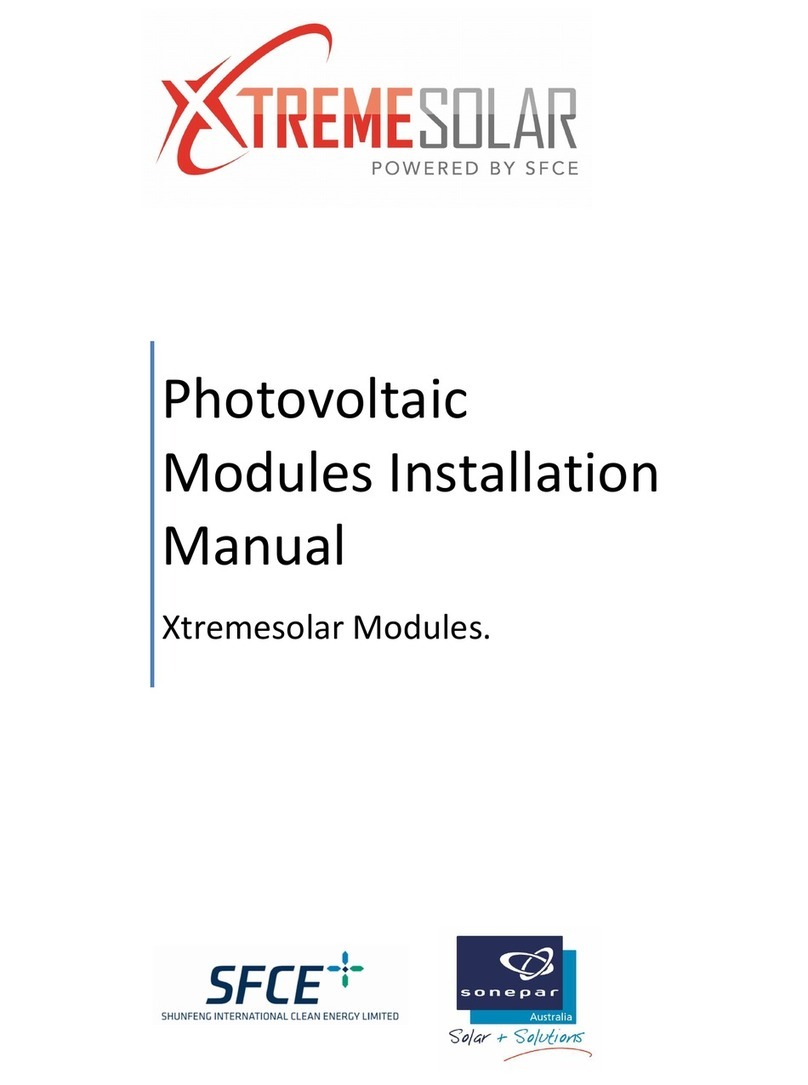
SFC Energy
SFC Energy XTREMESOLAR XTR-S290P Series installation manual

BenQ
BenQ PM200M00 installation guide
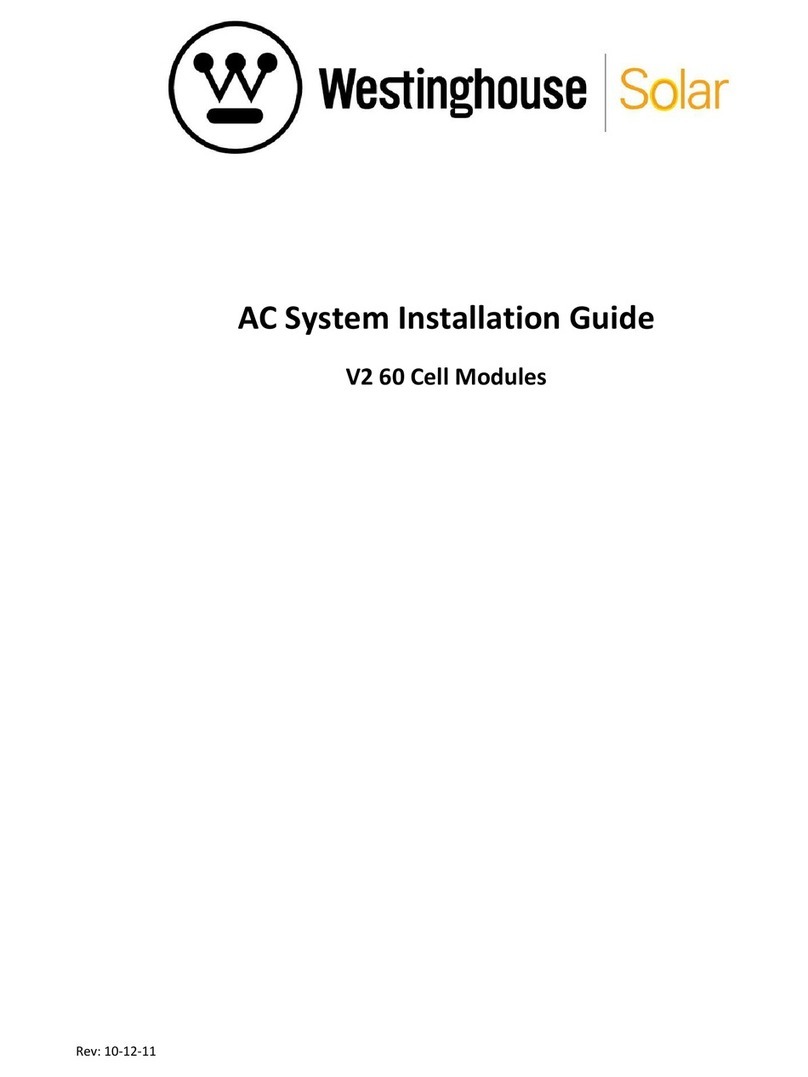
Westinghouse
Westinghouse AC System installation guide
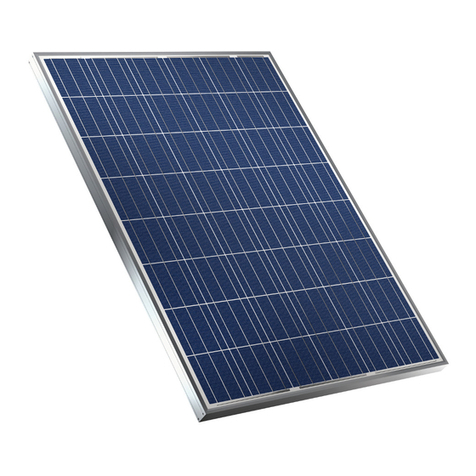
Viessmann
Viessmann Vitovolt 200 Operating Instructions for the System User

Flexopower
Flexopower SK79 instructions

